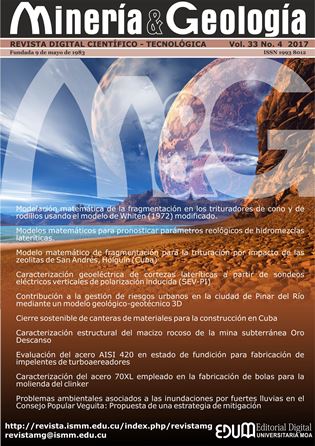Contribution to the management of urban risks in Pinar del Río city using a 3D geological-geotechnical model
Keywords:
geotechnics, geological-geotechnical model, geotechnical types, urban planning.Abstract
The objective of this paper is to elaborate a geological-geotechnical model in three dimensions for the Cenozoic section which is the shallowest of Pinar del Rio City. It is intended that the model obtained is used in future as an interpretative basis for geotechnical phenomena arising in the urban environment. The procedure fallowed can be easily applied to other worldwide studies, mainly in the areas that exist a big volume of geotechnical information. The procedure fallowed can be easily reproduced in other study cases worldwide, specifically counting on a wide volume of geotechnical information. Six Engineering Geological Types (EGT) are identified in the model, namely, Artificial fill, Vegetation layer, Marine alluvial coarse grained soil, Marine alluvial fine grained soil, Eluvial soil and Bed rock. The 3D geological-geotechnical model illustrates the spatial arrangement of the EGT above, and can contribute significantly at decision making in urban planning.Downloads
References
AGUADO, N. 1993: Esquema Ingeniero-Geológico de la ciudad de Pinar del Río. Informe inédito. Archivos de la Empresa Nacional de Investigaciones Aplicadas (ENIA) de Cuba, 4 p.
BANLAYÁ, J. C.; BARCOS, L.; BRUQUE, J. M.; CORDERO, T.; DÍAZ-AZPIROZ, M.; EXPÓSITO, I.; JIMÉNEZ, A.; MARTÍ, J. M.; MORAL, F.; OLÍAS, M.; ORTIZ, M. P.; ORTIZ, R.; PARRA, M.; RODRÍGUEZ, M. & VÁZQUEZ, M. A. 2013: Geología Urbana de Sevilla. Sociedad Geológica de España, Sevilla, 12 p.
BARRIOS, E.; MARRERO, J.; PORTUONDO, A.; NUÑEZ, R. & PLACERES, R. 1988: Levantamiento geológico a escala 1:100 000 y búsqueda acompañante Pinar Sur. Oficina Nacional de Recursos Naturales, La Habana, 4 p.
CABRERA, M. & PEÑALVER, L. 2001: Contribución a la estratigrafía de los depósitos cuaternarios de Cuba. Revista Cuaternario y Geomorfología 15(3-4): 37-49.
CALDERÓN, D. L.; LIVIA, C. M. & AGUILAR, Z. 2003: Consideraciones sobre la compresibilidad de suelos orgánicos y turbas. En: XIV Congreso Nacional de Ingeniería Civil del Consejo Departamental de Loreto del Colegio de Ingeniería del Perú, 1-11.
CHÁVEZ, M. & GUARDADO, R. 2008: Evaluación ingeniero-geológica del deterioro de las rocas en la provincia de Manabí, Ecuador. Minería y Geología 24(4): 1-13.
CHINTHAKA, G. A. 2015: Evaluación del potencial de expansión de los suelos en el Reparto Hermanos Cruz. Una contribución a la planificación urbana. Tesis de grado. Universidad de Pinar del Río. 107 p.
CHINTHAKA, G. A.; SAID, A.; ORDAZ, A.; ESTÉVEZ, E. & HERNÁNDEZ-SANTANA, J. R. 2016: Evaluación de la expansividad de los suelos en el reparto Hermanos Cruz, Pinar del Río, Cuba. Boletín Geológico y Minero 127(4): 811-826.
GIRBERT, Y. 2014: Pronóstico sobre la expansividad de las arcillas en la ciudad de Pinar del Río. Tesis de maestría. Universidad de Pinar del Río. 100 p.
GONZÁLEZ DE VALLEJO, L. I. 2002: Ingeniería Geológica. Pearson Educación, Madrid, 744 p.
GOVEA, D. 2014: Esquema Ingeniero-Geológico de la ciudad de Pinar del Río. Informe inédito. Archivos de la Empresa Nacional de Investigaciones Aplicadas (ENIA) de Cuba, 20 p.
HIBINO, T.; YAMAGUCHI, H. & KOGURE, K. 1989: Compression characteristics of highly organic soils. In: Symp. of highly organic soils: 19-28.
KOGURE, K.; YAMGUCHI, H. & SHOGAKI, T. 1993: Physical and pore properties of fibrous peat deposit. In: 11th Southeast Asian Geotechnical Conference. Singapore: 135-139.
LAPIDO, O. & PEREYRA, F. 2010: Geología urbana y ordenamiento territorial. Revista de la Asociación Geológica Argentina 66(4): 459-460.
NEUMANN, D.; SCHÖNBERG, G. & STROBEL, G. 2006: 3D-modeling of ground conditions for the engineering geology map of the city of Magdeburg. The International Association for Engineering Geology and the Environment (IAEG) 444: 1-7.
ORDAZ, A. 2013: Evaluación de las condiciones ingeniero-geológicas para el pronóstico de la respuesta dinámica de los suelos. Caso de estudio: Ciudad de San Cristóbal, Cuba occidental. Tesis doctoral. Universidad de Pinar del Río. 170 p.
REDOLFI, E. 2007: Suelos Colapsables. Manual. Universidad Nacional de Córdoba, 36 p.
RIENZO, F.; ORESTE, P. & PELIZZA, S. 2008: Subsurface geological-geotechnical modelling to sustain underground civil planning. Engineering Geology 96(3): 187–204.
ROCKWORKS 15: Earth Science and GIS Software. (Trial mode). Disponible en: https://www.rockware.com/product/productDemo.php?id=165
ROYSE, K.; REEVES, H. & GIBSON, A. 2008: The modelling and visualization of digital geoscientific data as a communication aid to land-use planning in the urban environment: an example from the Thames Gateway. Geological Society, London, Special Publications, 305(1): 89-106.
SIYAHI, B. G. & ANSAL, A. 1999: Manual for zonation on seismic geotechnical hazards. Technical Committee for Earthquake Geotechnical Engineering. Technical Committe 4: 68-70.
TOMÁS, R.; CUENCA, A.; DELGADO, J. & DOMÉNECH, C. 2004: Diseño de un modelo geológico-geotécnico 3D de la Vega Baja del río Segura (Alicante, SE España). En: XVI Congreso Internacional de Ingeniería Gráfica. Universidad de Alicante, España. Departamento de Expresión Gráfica y Cartografía, 1-10.
Published
How to Cite
Issue
Section
Copyright (c) 2017 Alexis Ordaz-Hernández

This work is licensed under a Creative Commons Attribution-NonCommercial 4.0 International License.
- Authors retain copyright and guaranteeing the right magazine to be the first publication of the work as licensed under a Creative Commons Attribution-NonCommercial that allows others to share the work with an acknowledgment of the work's authorship and initial publication in this journal.
- Authors may establish separate supplemental agreements for the exclusive distribution version of the work published in the journal (eg, place it in an institutional repository or publish it in a book), with an acknowledgment of its initial publication in this journal.
- Authors are allowed and recommended to disseminate their work through the Internet (e.g., in institutional telematic archives or on their websites) before and during the submission process, which can produce interesting exchanges and increase citations of the published work. (See The effect of open access)










